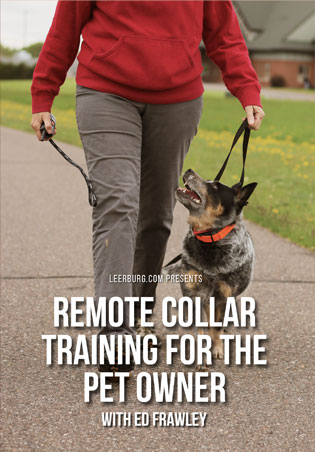Choose how you want to learn!
*To receive instant streaming access, you must be logged in with your Leerburg account during checkout.
Key Features
- Released Spring 2019
- Instructor: Ed Frawley
- Also available as a self-study online course! CLICK HERE to sign up!
Product Description
OUTLINE
- Chapter One - Introduction
- Segment 1 - The History of Remote Collars
- Segment 2 - Remote Collars are Not Bigger hammers or Sticks
- Segment 3 - Prerequisites to Start Training Your Dog With Remote Collars
- Chapter Two - Selecting Your Remote Collar
- Segment 1 - Terminology
- Segment 2 - Features you Need and Don’t Need on Your Remote Collar
- Segment 3 - Dogtra Collars
- Segment 4 - E-Collar Technology Collars
- Segment 5 - Selecting After Market Collar Straps
- Segment 6 - Charging Your Collars
- Segment 7 - No-Bark Collars Vs. Remote Collars
- Chapter Three - Habituating Your Dog To The Collar
- Segment 1 - Correctly Fitting Your Remote Collar
- Segment 2 - Habituating Your Dog to Wearing a Collar
- Chapter Four - Determining Your Dogs Stimulation Levels
- Segment 1 - Test Stimulation Levels on Yourself First
- Segment 2 - Introducing Our Dog to Low-level Stimulation
- Segment 3 - Establishing Our Dogs Working Stimulation Levels
- Chapter Five - Training The Dog with Remote
- Segment 1 - Pairing the Leash and Remote Collar
- Segment 2 - Get on the Dog Bed
- Segment 3 - Sit - Down - Recall
- Segment 4 - Walking with Your Dog
- Segment 5 - Leave-It
- Segment 6 - Aggressive and Reactive Dogs
DESCRIPTION
The purpose of a remote collar is not to punish a dog for not minding, but rather to redirect a dog from a distraction and get it to comply with what we are asking it to do with the least amount of force possible.
I purchased my first remote collar in 1978 and produced the first version of this course as a DVD in 2008. Quite frankly, the information in this new DVD (which was produced in 2019) is light years ahead of what I put into that DVD 11 years ago.
Training dogs with remote collars is one of the most misunderstood dog training tools ever invented. This DVD is going to simplify the training program for remote collars. It will also demystify old wives tails concerning "electric collar training".
We show new trainers that remote collars do not have to hurt our dogs. We also help trainers understand exactly when and how they should add collar training to their obedience program. Doing this correctly solves so many behavioral problems people have when they don't use remote collars the right way.
We cover how to select the right collar for you and your dog. Our feeling is that remote collars should be very easy to learn and simple to operate. Too many collars today have bells and whistles that only complicate their operation.
In a step-by-step manner, we cover when and how to introduce a dog to the feeling of low-level stimulation. When this is done correctly, our dogs do not get stressed. They also learn that stimulation does not hurt.
Once the dog has been introduced to what stimulation feels like, we have a protocol that determines the dog's working level of stimulation. Every dog is different. You will see that breed and size has nothing to do with what level of stimulation a dog needs to work.
In the chapter titled "Determining Your Dogs Work Level of Stimulation," you will watch us work with 15 dogs of different breeds and sizes. You can watch each of these dogs go through our protocol. That segment will convince you that every dog is different and the size of the dog has nothing to do with how it reacts to stimulation.
There is an old wives tale that remote collar training is painful for our dog. That may have been the case many years ago, but today that is 100% not the case. We teach pet owners to use low-level stimulation that is not at all painful. We compare working stimulation levels to a tap on the dog's shoulder reminding him that it needs to pay attention and follow directions.
The beauty of a remote collar can be seen when our dog is put in a highly distracting environment, like a deer or cat that jumps out and runs while out on a walk. With the remote, we have the ability to stop our dog from chasing.
The methods we used to determine our dogs working levels of stimulation have changed. We have learned a lot about working levels over the past 11 years. We learned that when dogs are correctly introduced to the feeling of low-level stimulation they will respond to levels so low that we humans cannot even feel the stimulation.
Have you used this product?
Your review helps others choose the right products for their dogs. Let them know what you think!
Write a ReviewThank You
Sandie and Mika
Remote Collar Training for the Pet Owner with Ed Frawley





